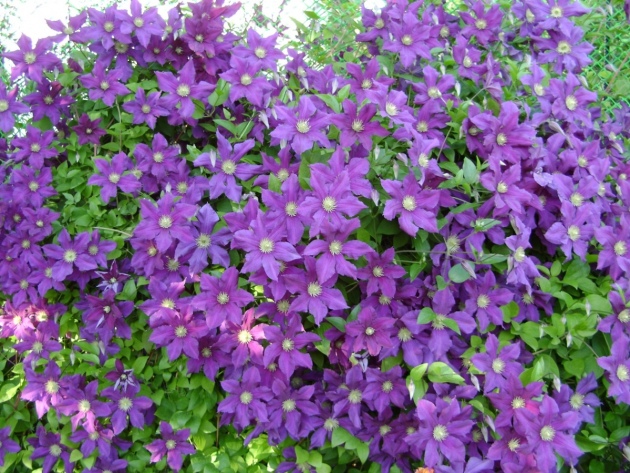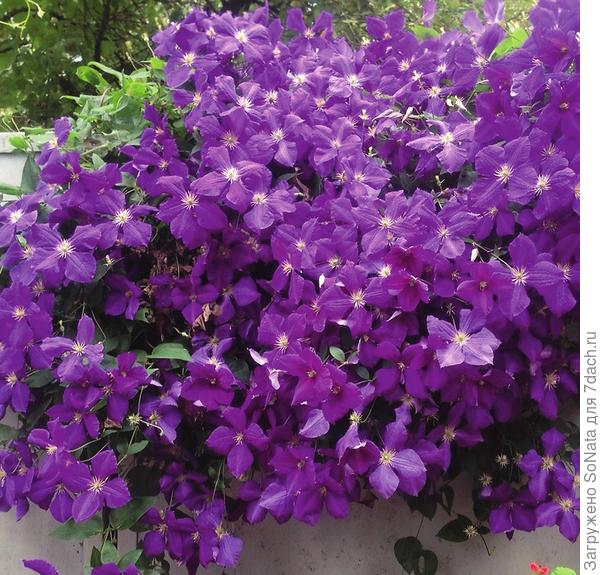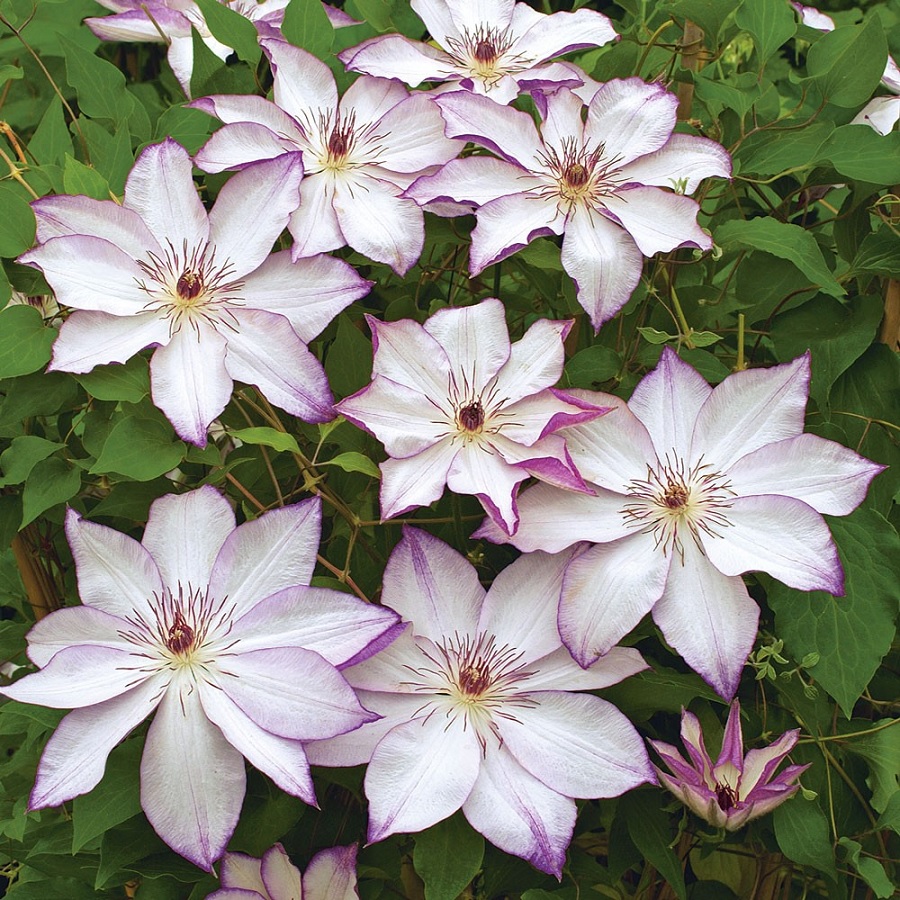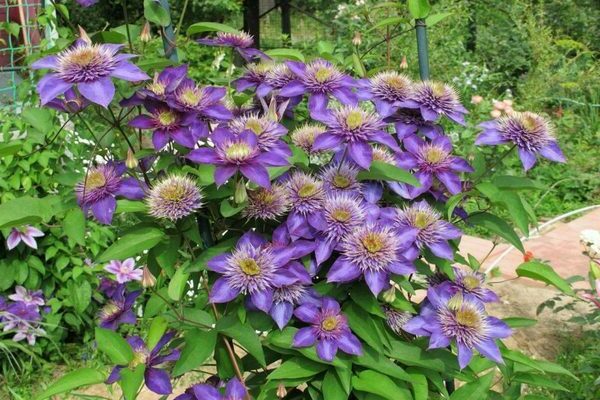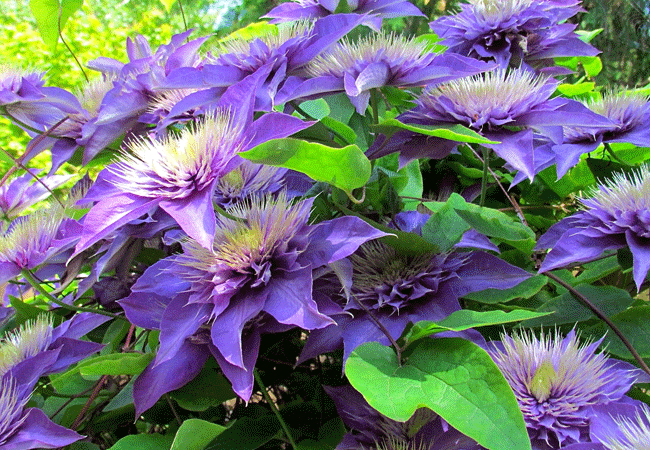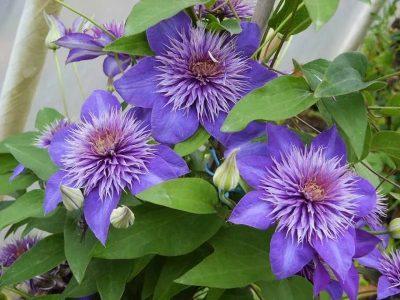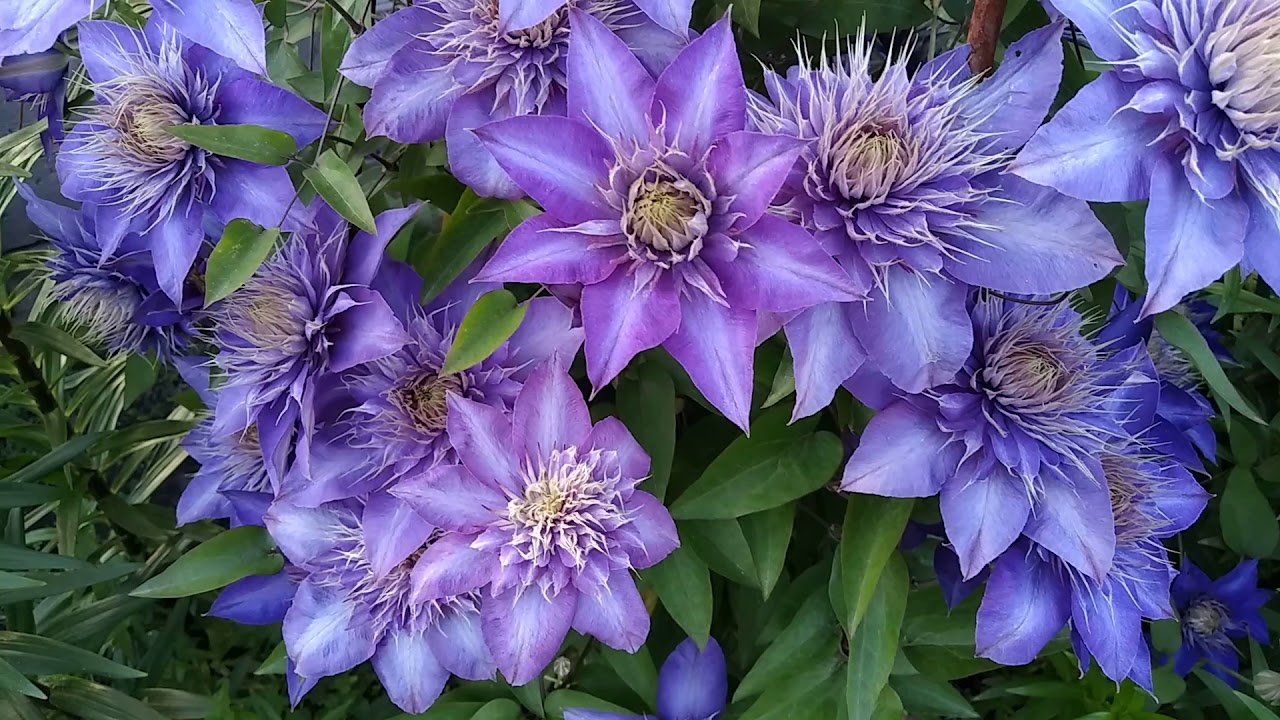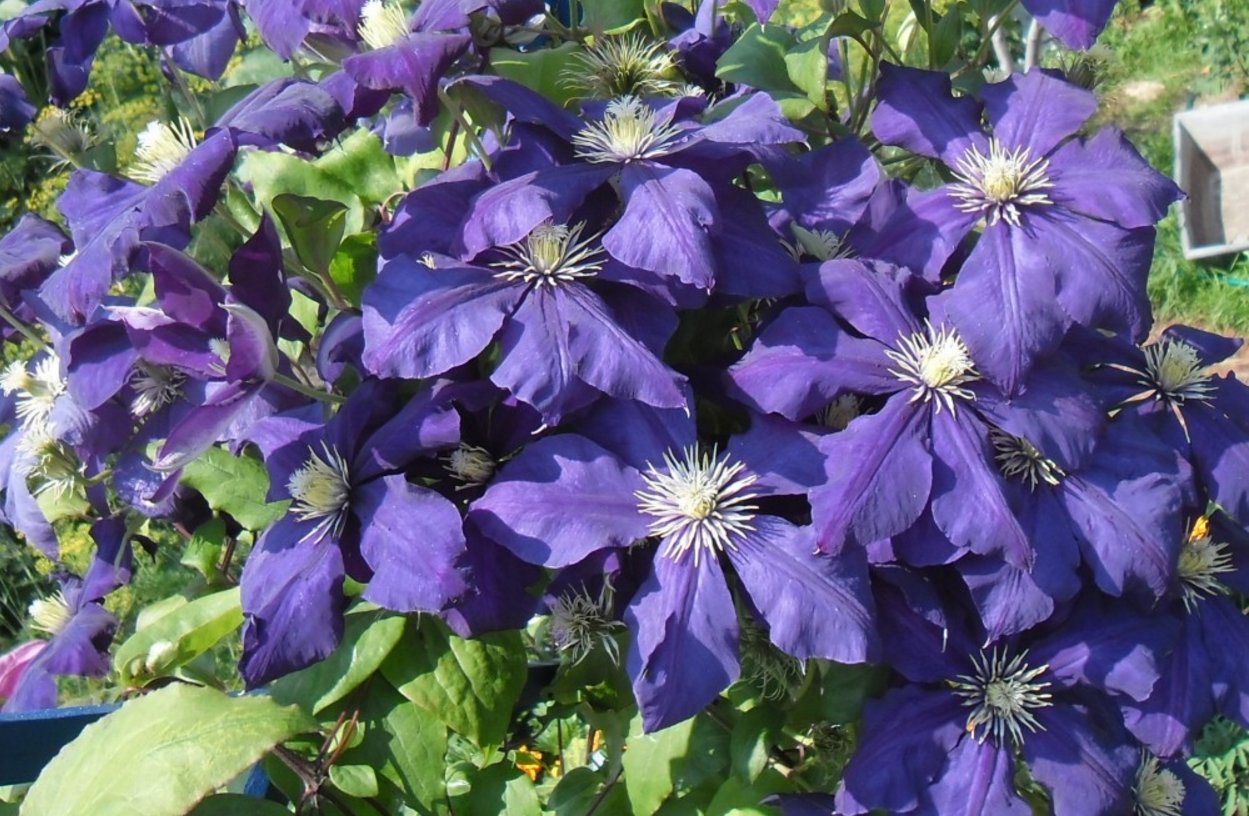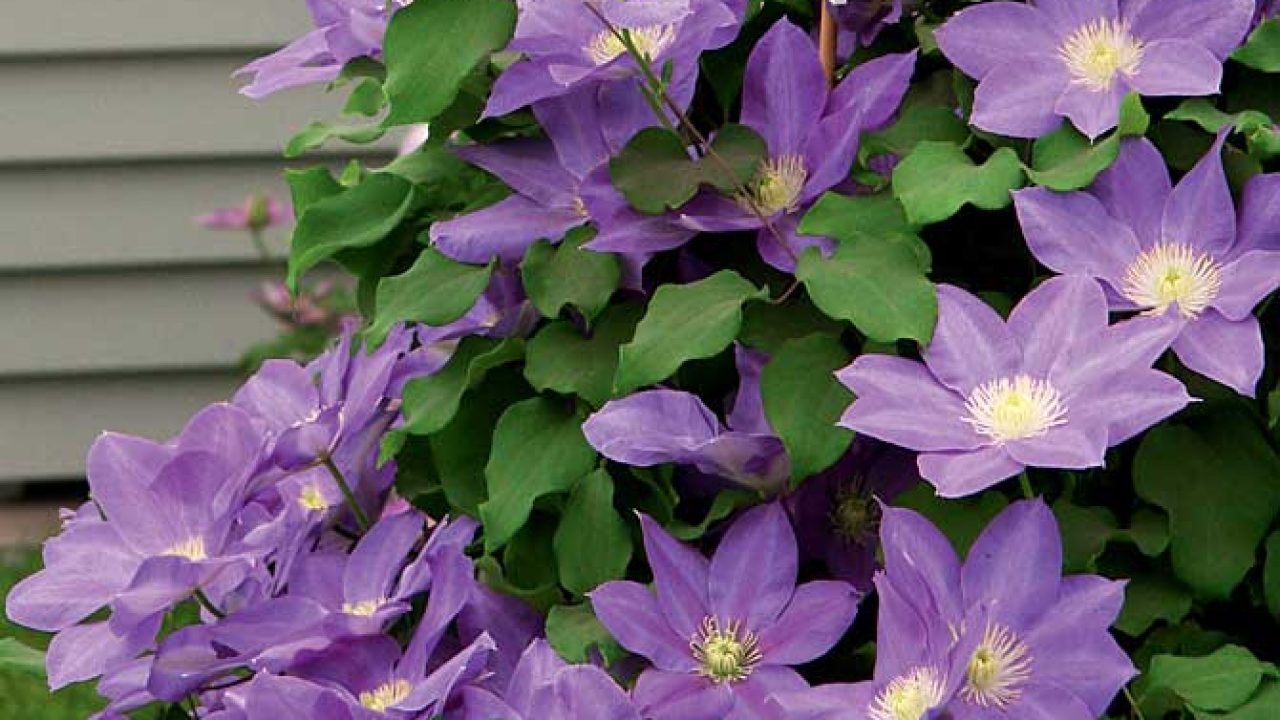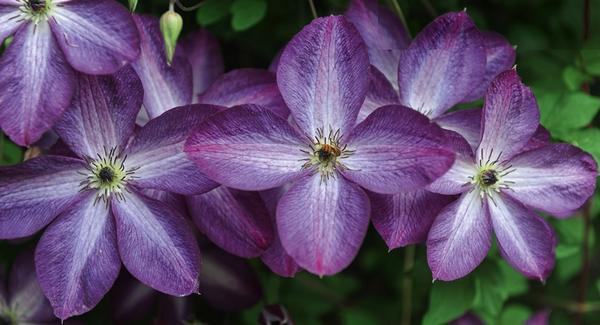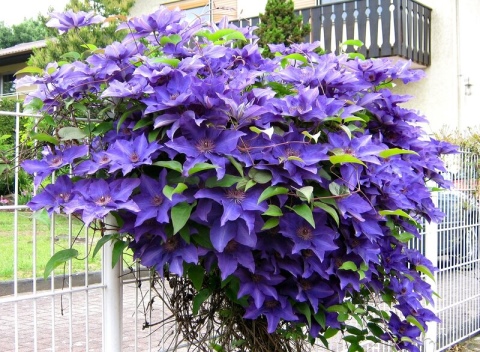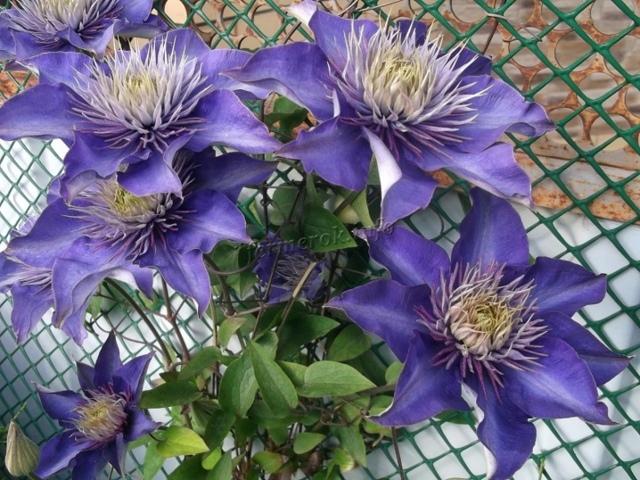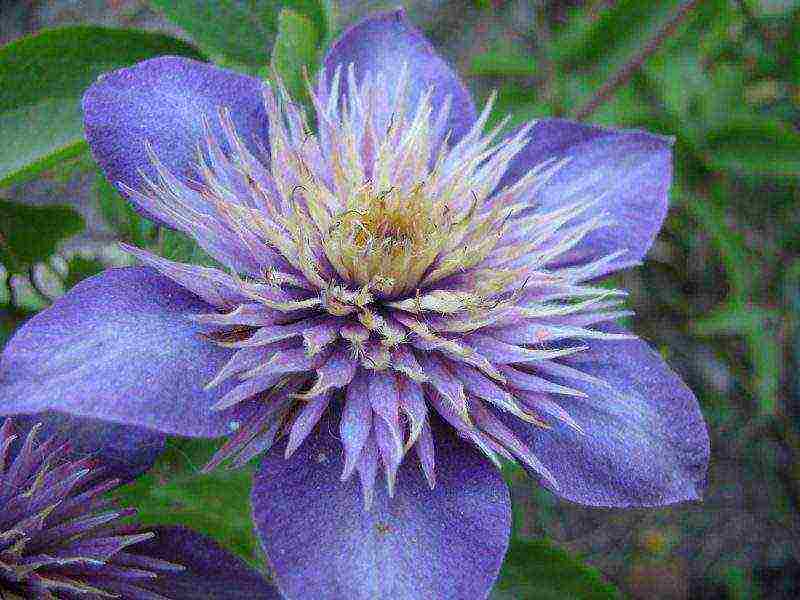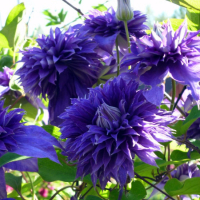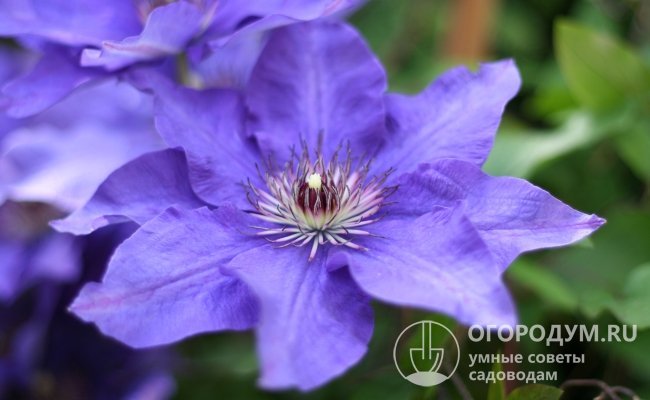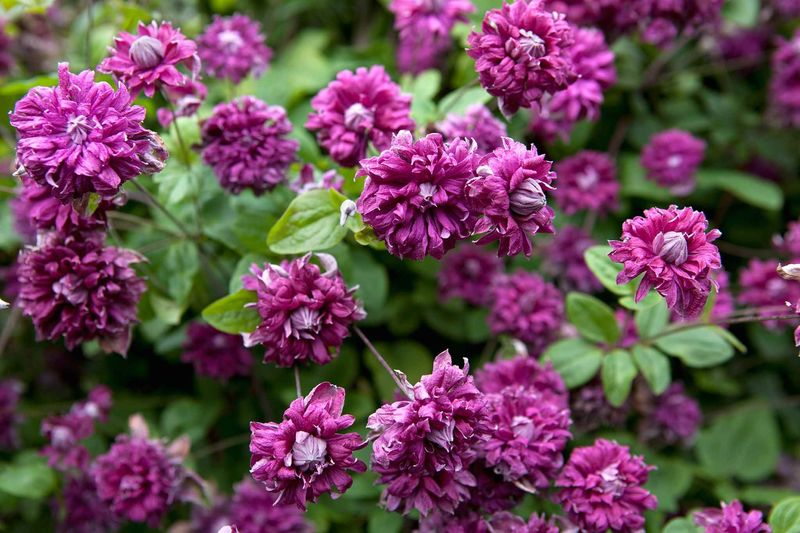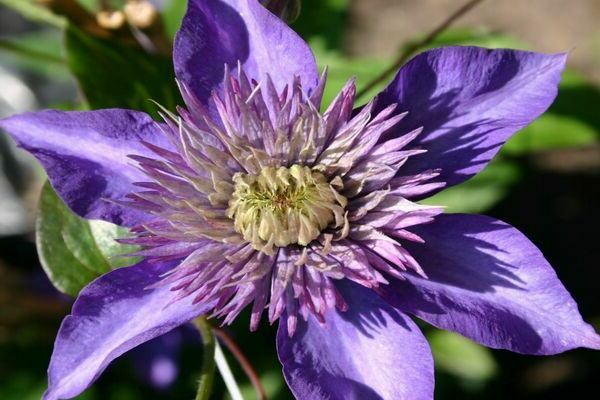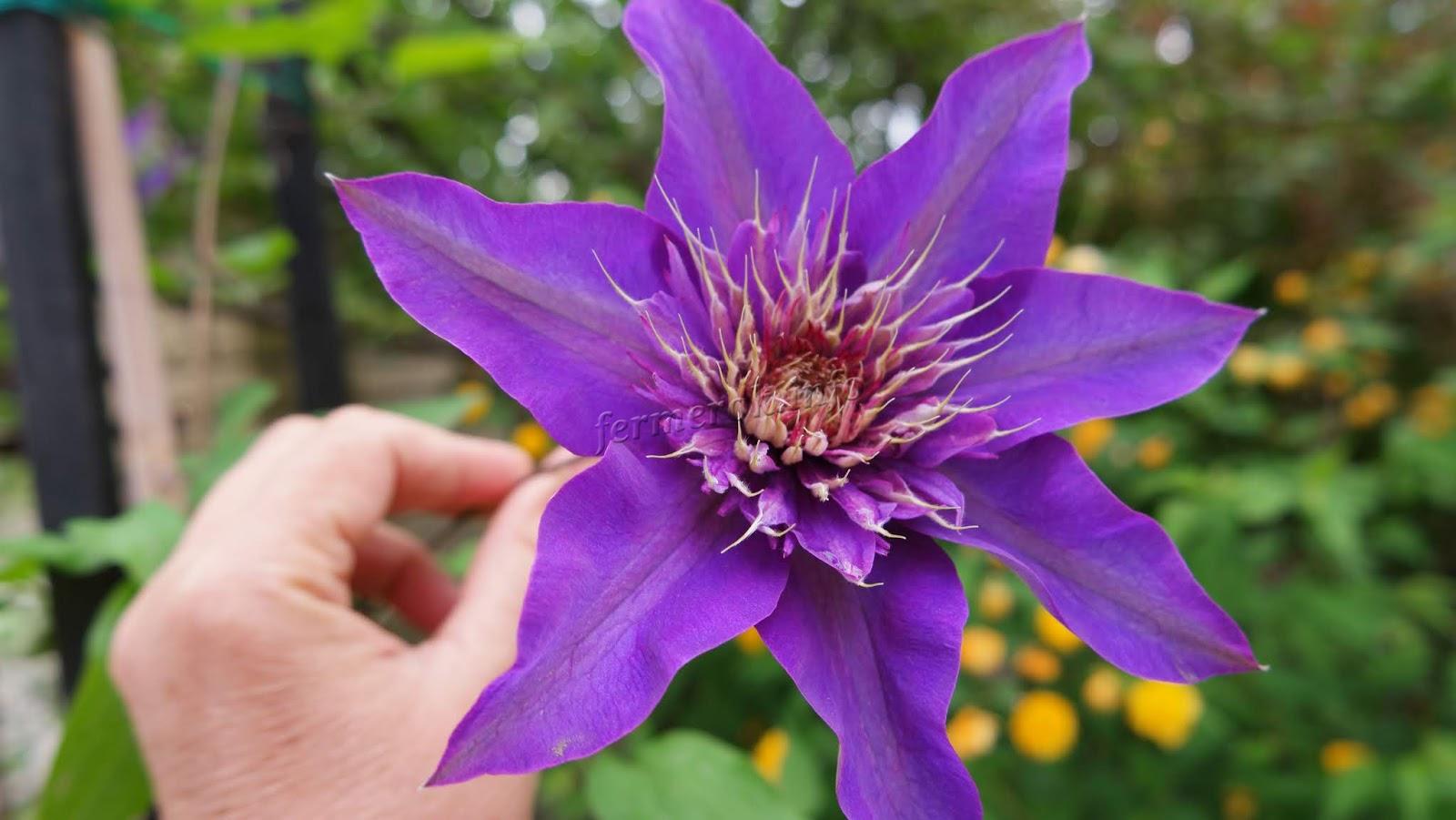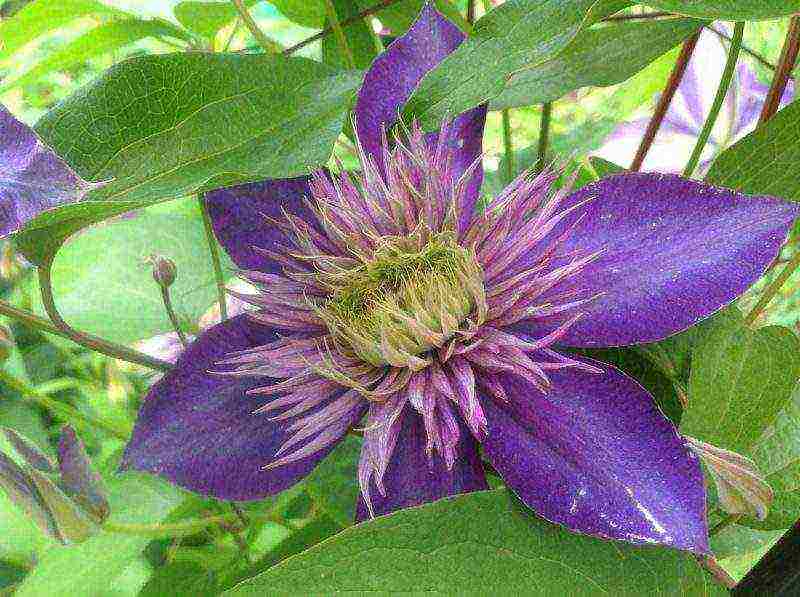Description
Clematis Multi Blue refers to low-growing dwarf vines, its height, as a rule, is no more than two meters. To stimulate the active growth of the plant, it needs a support, along which the culture will climb up with the help of young petioles.
The vine has oblong matte foliage, which has sharp tips and is painted in a rich green color. In length, the leaves reach 10 cm. Young petioles, as a rule, have a dark green color, but over time they begin to darken and become brown in color.
The flowers of clematis are double or semi-double. They have from 4 to 8 outer petals. They are round, elongated, flat, pointed, streaked with veins and slightly pubescent below.
In the central part of the bud, there are several short, needle-like petals that grow vertically. The core shape of flowers varies within the variety, and their color ranges from purple to sky blue. The stamens are yellow with a pinkish or reddish tint. The diameter of the fully opened buds is approximately 20 cm.

Clematis Multi Blue begins to bloom quite early, around May, for the reason that flowers are formed on shoots that appeared and grew last year. But buds are also formed on young branches, in this regard, after the 1st flowering period (from May to August), the 2nd (in September) may come. However, this only happens if there was no frost.
Growing clematis from seeds
Sowing seeds
In the huge variety of species and varieties of clematis for gardeners, there is a temptation to start breeding yourself. For those who are interested in growing clematis from seeds, we are ready to provide the necessary information about this process.
According to the size of the seeds and the duration of their germination, clematis are divided into three groups:
- Clematis with large seeds that germinate for a very long time and unevenly - from one and a half to eight months, or even longer (clematis of Durand, Jacqueman, purple, woolly, etc.);
- Clematis, the seeds of which are of average size and germinate within one and a half to six months (clematis whole-leaved, Manchurian, six-petal, Douglas, Chinese, etc.);
- Clematis with small seeds, germinating quickly and amicably - from two weeks to four months maximum (clematis Tangut, grape-leaved, etc.).
In the photo: Clematis seeds
Clematis seeds harvested this year germinate best, but if stored in paper bags at 18-23 ºC, it will last four years for germination. According to the sowing time, the timing is as follows: small seeds are sown in March-April, medium seeds are sown after the New Year holidays, and large seeds are sown immediately after harvest, in autumn or at the beginning of winter.
Growing honeysuckle honeysuckle - everything you need to know
To accelerate germination, the seeds must be soaked in water for ten days, changing the water 4-5 times a day. Then put in a container a substrate consisting of equal parts of earth, sand and peat, moisten it, spread the seeds on it in one layer, sprinkle it with a layer of sand 2-3 times the diameter of the seed and, slightly compacting, cover with a fine mesh or glass. The optimum temperature for germination of clematis is 25-30 ºC
From time to time, the substrate is gently watered into the pan so as not to wash the seeds, and the emerging weeds are removed
In the photo: Sprout of clematis grown from seeds
Saplings of clematis
When seedlings emerge, provide them with sufficient light, but protect them from direct sunlight.When the first true leaves appear in the seedlings, they dive into separate pots or bowls and grow in room conditions until the last frost has passed. Then the seedlings are transplanted to a shady area, into light soil, observing an interval of 15-20 cm between them. From time to time, pinch the plants so that they increase the root mass and branch more strongly. In the fall, cover your seedlings, and in the spring, transplant them again into a trench 5-7 cm deep, keeping a distance of half a meter between the seedlings. Shorten the shoots by leaving a few knots on them. After 2-3 years, when the seedlings have at least three elastic roots 10-15 cm long, they will be ready for transplantation to a permanent place.
In the photo: Clematis seedlings
Origin and characteristics of the plant
Hybrid variety "Hegley Hybrid" (Hagley Hybrid) bred in England in 1956 by the famous breeder Percy Picton (P. Picton). Medium-sized shrub vine. The height of the bushes does not exceed 2-2.5 meters. In the middle lane, the flowering period occurs in late June - early September. Fully open flowers are large, 12-18 cm in diameter, consisting of 6 pointed, slightly overlapping petals. The color is light pink, slightly lilac, with a delicate pearlescent tint and small purple-violet dots. The edges of the petals are slightly wavy; in the center of each there is a longitudinal "corrugated" strip. Anthers are dark, purple-claret.
 Open flowers can reach up to 18 cm in diameter, the color of the petals is light pink with a lilac tint and pearlescent tint, anthers are purple-burgundy
Open flowers can reach up to 18 cm in diameter, the color of the petals is light pink with a lilac tint and pearlescent tint, anthers are purple-burgundy
The variety blooms profusely on the shoots of the current year. Clematis "Hegley Hybrid", according to the reviews of Russian summer residents, tolerates severe winters very well. In areas of "risky farming" with insufficient shelter, vines can be slightly damaged by frost, but do not die. In frozen bushes, the activity of shoot growth decreases, the size of flowers decreases and the flowering period is shortened. In subsequent years, the plants are fully restored.
The variety is resistant to most diseases, almost not affected by pests. It is not very picky about the composition of the soil, but it gratefully responds to the annual feeding. According to some gardeners, the flowers of the bushes growing on "poor" soils become noticeably smaller over time.
Appearance of Clematis Multi Blue
According to the biological classification, clematis are perennial climbing plants. It is because of the long flexible stems that this ornamental culture is often called the liana. In total, there are more than 200 varieties of this flower in nature, but only 15 of them can be successfully grown in temperate and cold climates.
Flexible shoots of clematis can reach 5 meters in length, although most often their growth stops at 3 meters. These vines are able to climb vertical supports, clinging to them with leaf stalks. The color of the petals can be painted in a variety of colors, and the shade directly depends on the variety. For example, Clematis Multi Blue flowers are predominantly blue-violet, with small light areas in the center of the petal.
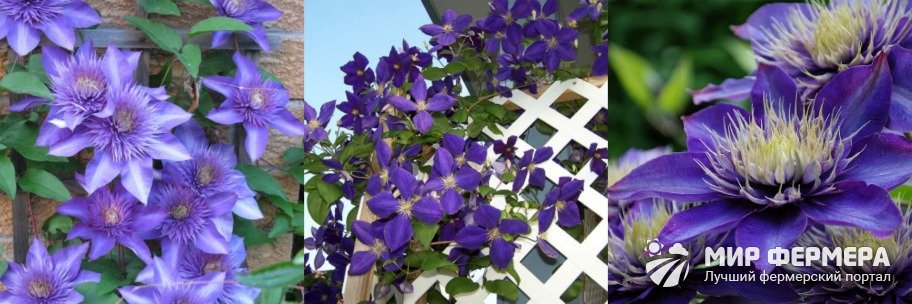 Figure 1. This is how Multi Blue inflorescences look
Figure 1. This is how Multi Blue inflorescences look
It should be noted that clematis belongs to fast-growing crops, but you should not expect its abundant flowering in the first year after planting. About three years after planting, clematis grows green mass and develops a root system, and blooms in about the fourth year. Of course, single buds can form before this time, but experienced flower growers recommend removing the buds so as not to weaken the plant.
If you successfully choose a place for planting a plant, clematis will successfully develop and bloom for at least 10 years, only for 15-20 years the culture will have to be transplanted to a new place. If we talk about the Multi Blue variety, then it is more suitable for the southern and temperate climates, and in the northern regions it often freezes due to the early onset of flowering (Figure 1).Since this article is devoted specifically to clematis of the Multi Blue variety, we will give a detailed description of the flower and the features of its cultivation in the open field.
Landing
Before planting clematis "Rouge cardinal", you should choose the right site and prepare the planting hole. The plant is very fond of light, but feels great both in areas illuminated by the sun and in partial shade. At the same time, it is not recommended to plant it under the trees, it is best to choose a place where there will be sun for half the day and shade for half. Fertile soil is considered a suitable soil for planting clematis; saline and heavy soils are contraindicated for the plant.
If acidic soil prevails on the site, then it must be neutralized before planting a flower.
Some gardeners also grow the plant from seed. This is quite painstaking work, but it is worth it, since as a result, you can grow a powerful and beautiful flower. Sowing dates "Rouge Cardinal" depend on the size of the seed: large grains are strong, they can be sown in late autumn, small ones will not withstand severe cold weather, so it is best to sow them in spring (from March to April). Seeds must be sown in open ground, and a small greenhouse should be set up to speed up sprouting.
Planting clematis "Rouge cardinal" from seedlings involves several steps.
- First, you need to dig a planting hole measuring 60x60x60 cm. Its lower half is filled with a special substrate. To do this, the top layer of the earth is mixed with humus and complex fertilizer (200 g).
- Then the seedling is carefully placed in the prepared soil, compacted and watered. The upper part of the planting hole should remain open, it will have to be gradually filled up as the plant grows. The neck of the bush should remain 10-12 cm below the ground. Thus, the development of lateral roots is activated.
- Planting ends with mulching. It is usually carried out 7-10 days after planting the seedling. Thanks to the mulch, the cutting will be reliably protected from winds and heat, this will also help to maintain an optimal temperature and humidity regime in the soil.
In the event that the plant was grown in a seed cup, then it is planted in a permanent place, adhering to several rules.
- First of all, you should inspect the roots, and if they are dry, then the glass should be soaked in cold water.
- Then the holes are prepared, from which part of the fertile soil is taken out. A small mound is formed at the bottom of the hole, it must be tamped with your hands. The seedling should be placed on the very hill of the hill. It is carefully removed from the glass, so as not to damage the integrity of the earthen coma, and placed on the bottom of the hole.
- After that, the root system is covered with a previously extracted layer of fertile soil and sprinkled with the root collar, part of the stem. At the end of planting, the seedling is well watered, the water should be at room temperature.
When planting several flowers on a site, it is important to maintain a distance of 1.5 m between them.Over the summer, you should monitor the development and growth of the plant
If there is a minimal increase, and clematis looks depressed, then this indicates that the place did not suit him. It is possible to solve this problem by transplanting the plant to another site, this should be done as early as next spring.
Caring for large-flowered clematis Red Star
Caring for clematis, pay attention to the state of the trunk circle, watering, regular feeding and pruning
Growing conditions
Having planted clematis on soil enriched with mineral fertilizers, they take care of the vine. As shoots appear, the whips are tied to a support. If clematis is planted in a sunny area, the roots of the vines protect from overheating. Ground cover plants are planted in the trunk circle, in which the superficial root system does not compete with clematis.
Watering mode
Clematis requires abundant watering, 10-15 liters of water at a time, and an adult bush is larger. The bush is watered once a week; during a drought, watering is increased. When using a hose, do not direct the jet directly to the root. Sprinkle the bush in the evening if there is a drought.
Top dressing
In the first year after planting, the vine is not fed. For the development of the bush, there are enough mineral fertilizers from the planting substrate. The next spring, in April, after the snow has melted, nitrogenous fertilizing is introduced for better growth of the lashes:
- ammonium nitrate;
- urea;
- humus.
When it comes time to set buds, the Red Star hybrid is fed with complex fertilizers for flowering plants or nitrophos. The third feeding is carried out in August with phosphorus-potassium preparations.
Comment! For better flowering, Red Star clematis is fed every 15-20 days.
Mulching and loosening
Immediately after planting, the stem circle of Red Star clematis is mulched with straw, dry or fresh grass, and bark. If the hole is left without mulch, the soil is loosened after each watering. Remove weeds. Weeds have long roots and compete with clematis for nutrients in the soil. Ground covers with a superficial root system are planted in the trunk circle of an adult clematis. Greens will shade the soil if the vine is planted in direct sunlight. The unprotected root system of beautifully flowering vines in such cases suffers from overheating of the soil.
Tying
The tenacious petioles of the Red Star clematis leaves, according to the photo and description, independently climb along the support. Tying is necessary only if the lashes are directed in the desired direction. Also, from the beginning of spring, the vines help the garter to hold onto the support if it is planted in a place blown by the wind. To fasten the lash, a soft and light material is used that will not damage the delicate green liana.
Formation and pruning of clematis Red Star
The seedling is given attention already in the first season:
- for the development of a powerful Red Star bush, the buds that appear on the seedling are cut off;
- also in the first year of growth of clematis, pinch the top, which stimulates the formation of new shoots;
- in the fall, all the lashes are cut off on the ground, except for the central shoot, which will serve as an impetus for the thickening of the bush in the next season;
- the length of the central whip is left up to 40 cm.
Pruning last year's Red Star creepers after the first flowering stimulates more abundant blooming of buds by autumn on shoots that have grown since spring. In October, Red Star is shortened to 150 cm.If the vine is cut in the spring, the frozen tops are removed to live buds, which have already swollen. With heavy pruning, the May or June bloom will be less abundant, but the buds will form much more luxuriantly. Florists recommend leaving 14-15 lashes in winter, and shortening the rest at the very soil. Sanitary pruning is carried out at any time by removing damaged lashes.
Preparing for winter
The Red Star hybrid is frost-resistant - under the thickness of the snow, the bush does not suffer even at minus temperatures of 30 ° C. In autumn, the root zone is sprinkled with humus or earth, up to 15 cm high. Sprinkle with wood ash on top, which is a prophylaxis against fungal diseases. With the onset of cold weather, clematis is covered by:
- after cutting the whips of the Red Star hybrid, they are carefully laid on cardboard or boards so that they do not come into contact with the ground;
- a frame or wooden box is installed on top, which is covered with spruce branches or burlap;
- snow is thrown over the structure in winter, and removed in spring.
If clematis remains uncovered, the shoots may freeze slightly. But new ones will grow in spring, only flowering will be late, by the end of summer.

